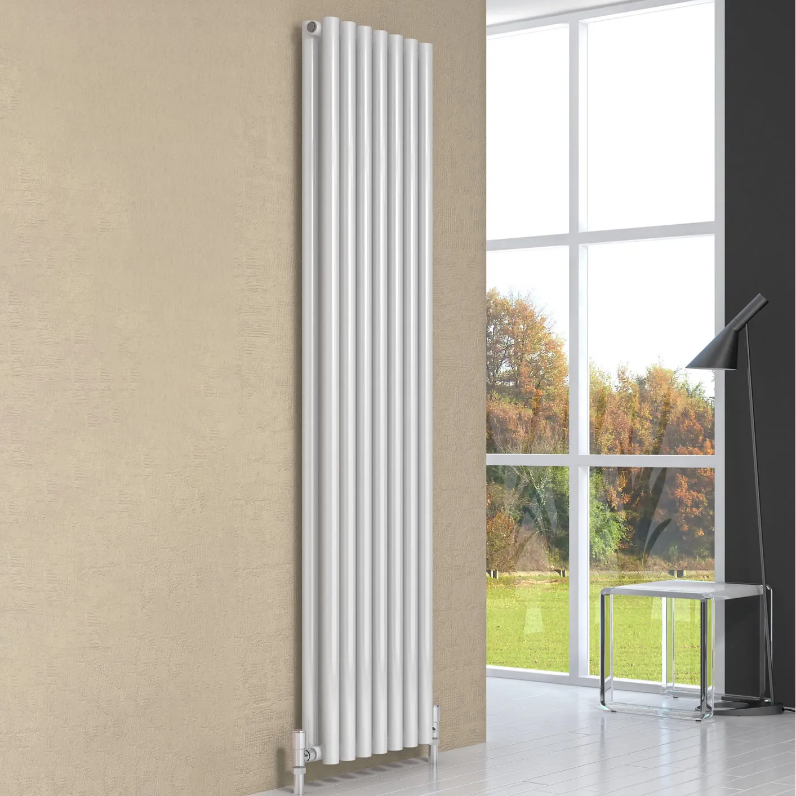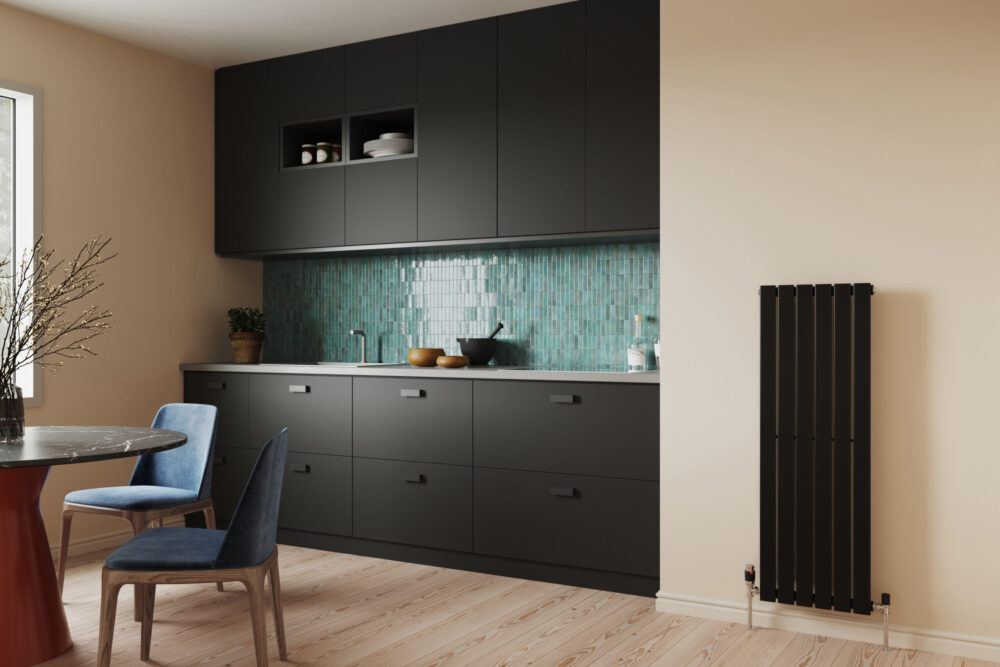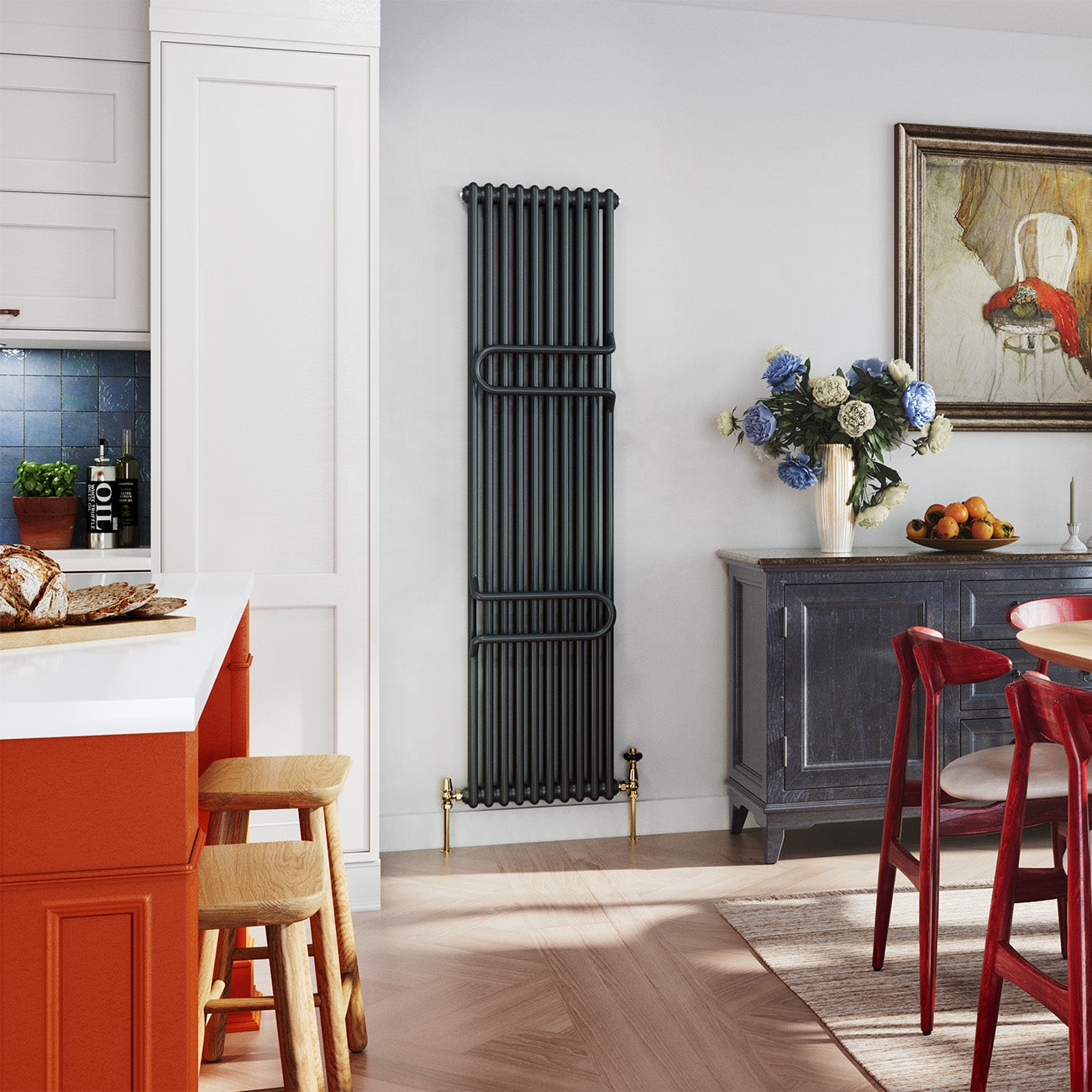
The Ultimate Guide to Kitchen Radiators
The heart of the home
The kitchen is known as the heart of the home, and for good reason. It’s the place where you come after a long day at work (from home) to pour a glass of wine, prepare food for the family and spend some time with your loved ones. It’s become the epicentre of our homes and families, so creating the right atmosphere is more important than ever.
When it comes to home decor, we want to target the 5 senses to create a homely atmosphere. This is why there’s such an emphasis on interior design and decorating your home with candles, fragrance diffusers and other stylistic touches. But one easily forgotten element of creating that perfect atmosphere is temperature.
The temperature of a room can really dictate the vibe in your home, and if your home heating system isn’t up to scratch, the inviting, friendly atmosphere you’re trying to create will go out the window (literally). So keeping your home warm is about more than just toasty toes.
Why are kitchen radiators so important?
You might be wondering, how are kitchen radiators any different to regular radiators? Well, besides the fact that they’re situated in such an important area of your home, the requirements of kitchen radiators are quite specific too. Let’s look at them in a little more detail.
They can be large spaces
Kitchens are often big rooms that need powerful heating, so you need a radiator that can pack a punch and spread heat to each corner of even the biggest room. Kitchen radiators boast powerful heat outputs (which you can find more about in our BTU Guide) and impressive energy efficiency too. With more and more kitchen renovations nowadays including an extension to open up people’s spaces more, kitchen radiators have never been more important. Sure, an open-plan design that brings the outside in is great during the summer months - but in the winter this can make your kitchen draughty and chilly. So getting the right radiators for kitchens is crucial.
They need more heat than other rooms
As we’ve already mentioned, kitchens are increasingly connected to our outside spaces, but even in original buildings, the kitchen often backs onto the garden or features a side entrance to the house. And that means one thing - draughts. This calls for more heat to make up for the warm air that can be lost with doors opening and closing, so kitchen radiators need to offer powerful heating that can keep your space warm, whether you’re busy cooking or entertaining guests.
They need to be flexible
Whilst radiators for kitchens do need to be powerful, they also need to be flexible with the heating that they offer. The main activity that takes place in a kitchen is cooking, and with hobs fired up and ovens hot, your kitchen can end up producing its own heat. And this is more the case for smaller kitchens in particular where the heat travels around the room much faster. Technology has given us the gift of flexibility with heating, with options like aluminium radiators offering not just heating power, but quicker heating and cooling times that allow you to have heat on demand, and won’t turn your kitchen into a temporary sauna if it gets too warm. In the same vein, dual powered kitchen radiators can provide the flexibility of being connected to your central heating system or working independently.
They have different purposes
Similar to bathroom radiators, kitchen radiators often do more than simply heat a room up. Your heater can double up as a kitchen towel rail and keep those tea towels crisp and dry, ready to wipe up a spill or dry your hands.
Where to place radiators for kitchens
Kitchens are notoriously busy rooms. With counters, sinks, cookers and ovens to fit in, it can be easy to forget to pick a spot for your radiator. But you can’t just fling it on any old wall. Where you choose to place your radiator can affect its performance just as much as choosing the wrong heat output. A great place for radiators to sit in any room is underneath a window, as the air coming in assists the flow of heat around the room. In a kitchen, however, underneath the window is a pretty coveted space, and it’s likely that your sink or worktop will sit under there. You want your radiator to be in an area of the room where it can emit heat effectively, which brings us onto the next point: where not to place kitchen radiators.
And where not to place kitchen radiators
When it comes to placing kitchen radiators, there are 2 main things to remember:
- Keep it away from the fridge
- Don’t obstruct it
Simple, right? Firstly, the reason why you should avoid placing your radiator near the fridge or freezer is because these appliances get rid of residual heat through the condenser situated at the back of them. This means they’ll directly take away from the heat the radiator supplies, meaning that they’ll have to work twice as hard to keep your food cool while your radiator won’t be delivering the heat you want. Both appliances will use up more energy and ultimately waste money, which is a lose-lose situation that you don't want to be in. Luckily, this is easily avoided by ensuring that kitchen radiators are placed away from fridges and freezers. The next thing to remember is a common practice for all rooms, not just when it comes to kitchens. Covering or blocking a radiator will directly hinder it in heating up a room, whether it’s with a radiator cover or a piece of furniture, so keep this in mind when remodelling your kitchen to get the most out of your heating system. How to choose the perfect kitchen radiators for your space Choosing a radiator should be fun, but it can get a little stressful when you see how many models, sizes, styles and heat outputs are on offer. But we’ve got you covered, with suggestions and inspiration on the blog, and everything you need to know about kitchen radiators right here.
Think about your wants and needs
Do you use your side or back kitchen entrances a lot? Do you often use your kitchen as a working or leisure space? Or maybe it’s the opposite and your kitchen is solely the place that you keep the food? However you use your kitchen, or whatever you want to get out of it, your heating needs will vary accordingly. If you need some more tips, read our guide to choosing the right radiator for your space or contact us if you fancy a chat with one of the team.
For larger kitchens, try vertical kitchen radiators
Vertical kitchen radiators can make great statement pieces and liven up an otherwise bare wall, as well as deliver substantial heating power for large spaces. If you want to be able to dry your tea towels too, then consider a kitchen towel rail - it’ll give you power and dual purpose! They’re available in a range of sizes and colour options too, so you don’t have to compromise on style. From on-trend anthracite to classic white, you can keep your decor style consistent right down to your kitchen towel rail.

For smaller spaces, try a small radiator
If you have a small kitchen and are short on space, then slimline radiators are the ideal wall radiators for you. They can be great space savers that still offer you powerful heating to ward off even the coldest of draughts. If you’re ready to find your next kitchen radiator, then your search starts right here at UK Radiators. And if you need any help along the way, don’t hesitate to get in touch and a member of the team would be happy to assist you.
For modern styles, try matt kitchen radiators
For those wanting a kitchen towel rail to match a trendy, modern kitchen, then you need a matt kitchen radiator. This sleek finish will perfectly complement your kitchen tiles or add a modern contrast to a more traditional kitchen.
For vintage styles, try column radiators
Column radiators make great kitchen radiators, as they offer powerful heating in a range of different styles and sizes. The ideal partner to a vintage, classically decorated kitchen, these long-lasting and versatile radiators are just what you need to complete your kitchen. On the other hand, a modern take on the classic column radiator, like the one here from our customer Anthony’s kitchen, fits in perfectly with an on-trend interior.
If you’re ready to find your next kitchen radiator, then your search starts right here at UK Radiators. And if you need any help along the way, don’t hesitate to get in touch and a member of the team will be happy to assist you.









